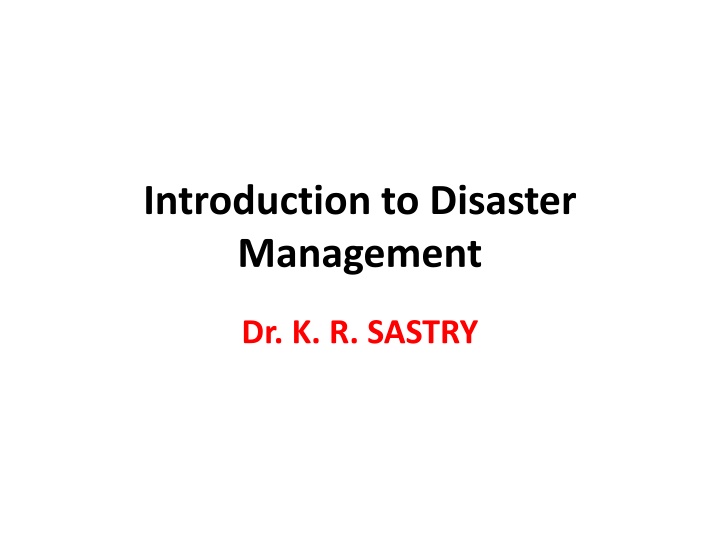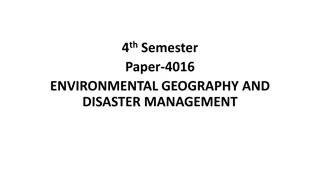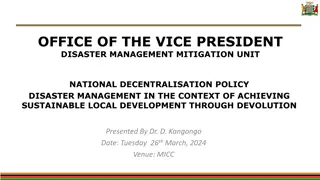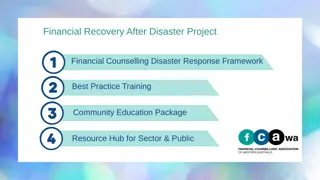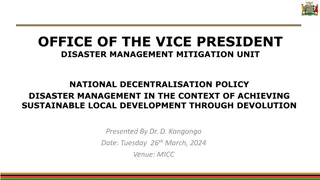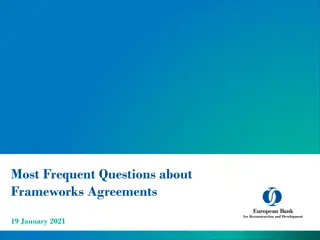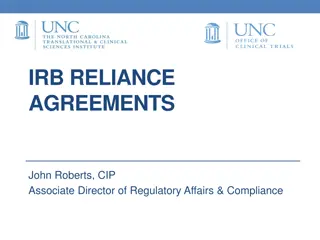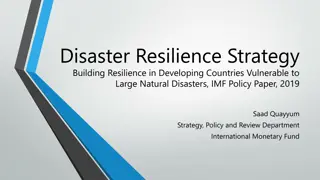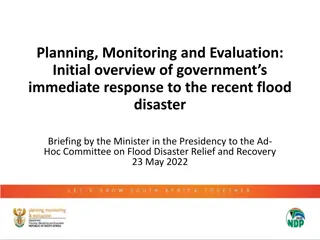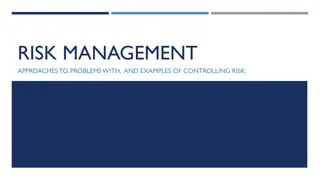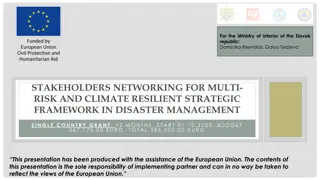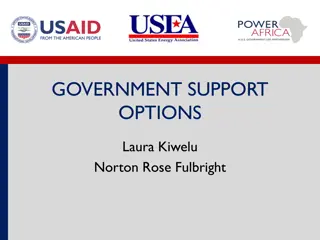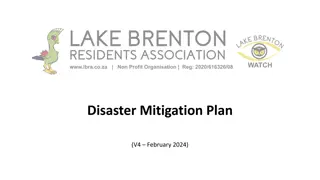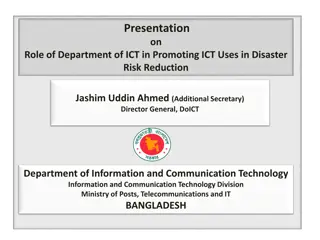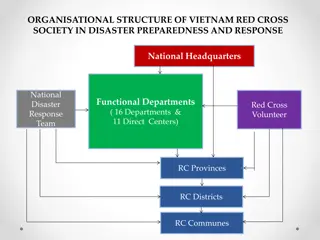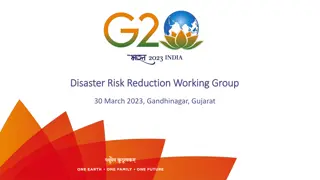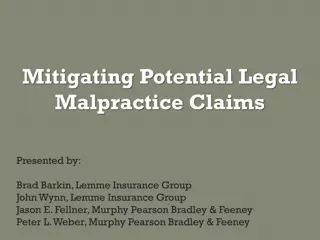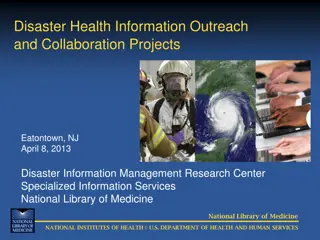Introduction to Disaster Management: Types of Risks and Global Agreements
The content covers various aspects of disaster management, including types of risks faced, global agreements, vulnerability rankings, and causal factors contributing to disasters. It emphasizes the importance of understanding disasters as a serious disruption requiring effective mitigation strategies.
Download Presentation

Please find below an Image/Link to download the presentation.
The content on the website is provided AS IS for your information and personal use only. It may not be sold, licensed, or shared on other websites without obtaining consent from the author.If you encounter any issues during the download, it is possible that the publisher has removed the file from their server.
You are allowed to download the files provided on this website for personal or commercial use, subject to the condition that they are used lawfully. All files are the property of their respective owners.
The content on the website is provided AS IS for your information and personal use only. It may not be sold, licensed, or shared on other websites without obtaining consent from the author.
E N D
Presentation Transcript
Introduction to Disaster Management Dr. K. R. SASTRY
Type of Risks The Risks, generally encountered are: Daily: Unemployment, Poverty, Disease, etc. Major Disasters: Floods, Storms, Quakes, etc. Emerging Risks: Pandemics, Climate change, etc.
General Introduction The Sendai Framework for Disaster Risk Reduction (SFDRR) was the first international agreement adopted within the context of the post-2015 development agenda Two other major international agreements followed it in the same year, are the Sustainable Development Goals (SDGs) 2030 in September 2015; and The UNCOP21 Climate Change agreement to combat human-induced CC in December 2015 at Paris As such, the DRR is a common theme in all these three Global Agreements
The German Watch India is the Sixth most vulnerable country in the World in terms of facing extreme weather events Haiti, Zimbabwe, Fiji, Sri Lanka and Vietnam taking the top Five positions in the fresh list of nations facing climate risk On the other hand, Cuba, South Africa, Bangladesh--are deemed the best Disaster Management Systems in the World During the decade of 2005-2015, India faced 167 Natural Disasters & lost properties worth Rs. 3.3 lakh Cr. It was reported that India lost maximum no. of human lives (i.e., 2,119) in 2016 alone; besides, loosing about 1.5 lakh Cr., worth of property, crop losses, etc.
Definition of Disaster A serious disruption of the functioning of a society, causing (a) widespread human, (b) material, or (c) environmental losses, which exceed the ability of the affected community/society to cope using its own resources. In other words, It s the product of a hazard: Earthquake, Flood, windstorm, etc., coinciding with a vulnerable situation, which might include communities, villages or cities There are two (2) main components : Hazard and Vulnerability Without vulnerability or hazard, there is no disaster. A disaster occurs when and where hazards and vulnerability meet at a time and space Hazard X Vulnerability Disaster= ------------------------------ Capacity
Causal Factors 1. Environmental degradation; 2. Deforestation & Soil erosion; 3. El Nino (Global warming) & La Nina: (Global cooling) Effects; 4. Lack of Awareness & Information; 5. Poverty, Unemployment, Disease; 6. Fast Population Growth; and 7. Rapid Urbanization (Surat Plague)
Disaster Management Cycle DM can be divided into: pre-disaster, during- disaster and post-disaster phases There are 3 key stages of activity that are taken up within DM: (a) Pre-disaster; (b) During Disaster; & (c)Post-disaster phases Disaster Management is the policy & admin decisions & operational activities pertaining to various phases of a disaster at all levels
Disaster Management Act: 2005 Institutional & Legal Arrangements NDMA SDMA DDMA NEC (National Executive Committee) NDRF SDRF
Nodal Agencies for Management of Disasters in India Floods : CWC, Ministry of Water Resources Cyclones : Indian Meteorological Department (IMD) Earthquakes : Indian Meteorological Department (IMD) Epidemics : Ministry of Health & Family Welfare Chemical Disasters : Ministry of Environment & Forests Industrial Disasters : Ministry of Labor Rail Accidents : Ministry of Railways Air Accidents : Ministry of Civil Aviation Fire : Ministry of Home Affairs Nuclear Incidents : Department of Atomic Energy Mine Disasters : Department of Mines
State Disaster Management Authority Establishment of State Disaster Mgt. Authority Meetings of the State Disaster Mgt. Authority Appointment of Officers/other employees of State Authority Constitution of advisory committee by the State Authority Powers and functions of the State Authority Guidelines for minimum standard of relief by State Authority Constitution of State Executive Committee (SEC)
District Disaster Management Authority Constitution of District Disaster Management Authority (DDMA) District Collector is the Chairman of DDMA; and, his powers to manage emergencies Conducts Meetings Constitution of Advisory Committees Appointment of officers & other employees of DDMA
National Disaster Management Authority (NDMA) Constituted on 30thMay 2005 Members Hon ble Prime Minister as the Chairperson Nine members nominated by Chairperson Chairperson to designate a Vice- Chairperson from among its members
National Institute of Disaster Management (NIDM) Mandate and Members National Centre for Disaster Management was established at the Indian Institute for Public Administration (IIPA) in 1995 The Centre was upgraded and designated as the National Institute of Disaster management (NIDM) on 16th October 2005 NDMA Vice Chairperson is the Chairperson of the Governing Body of NIDM Union Home Secretary is the Vice- Chairperson 12 Other members
National Institute of Disaster Management (NIDM) Mandate and Members National Centre for Disaster Management was established at Indian Institute for Public Administration (IIPA) in 1995 It was upgraded and designated as the National Institute of Disaster management (NIDM) on 16 October 2005 NDMA Vice Chairperson is the Chairperson of the Governing Body of NIDM Union Home Secretary is the Vice- Chairperson 12 Other members
National Disaster Response Force (NDRF) Mandate NDRF is constituted under Section 44 of the DM Act, 2005, as a specialist force to respond to disaster like situations, Chemical, Biological, Radiological and Nuclear (CBRN) calamities and natural calamities The general superintendence, direction and control of NDRF is vested in NDMA Personnel of Border Security Force (BSF), Indo-Tibetan Border Police (ITBP), Central Industrial Security Force (CISF), Central Reserve Police Force (CRPF)--comprise the NDRF; and, it s stationed in 11 locations all over in India
Map showing NDRF Bns locations and their respective area of responsibility Source:http://ndrfandcd.gov.in/cms/Ndrf.aspx
State Disaster Management Authority Establishment of State Disaster Mgt. Authority Meetings of the State Disaster Mgt. Authority Appointment of Officers/employees of State Authority Constitution of advisory committee by the State Authority Powers and functions of the State Authority Guidelines for minimum standard of relief by the State Constitution of State Executive Committee (SEC)
District Disaster Management Authority Constitution of District Disaster Management Authority (DDMA) District Collector is the Chairman of DDMA; and, his powers to manage emergencies Conducts Meetings Constitution of Advisory Committees Appointment of officers & employees DDMA
Guidelines for Minimum Standards of Relief Minimum requirements like water & food to be provided to the affected in the relief camps Special provisions to be made for widows & orphans Ex-gratia assistance on account of loss of lives, damage to houses & for restoration of means of livelihoods Such other relief, as may be necessary
Finance, Accounts and Audit National Disaster Response Fund (Sec.46) National Disaster Mitigation Fund (Sec.47) Establishment of funds by State Govt. (Sec.48) Allocation of funds by Ministries & Dept s (Sec.49) Emergency procurement & accounting (Sec.50)
Offences and Penalties Punishment for obstruction, etc. Punishment for false claim Punishment for misappropriation of money or material Punishment of false warning Offences by Departments of the Government Failure of officer in duty or his connivance at the contravention of the provisions of this act Penalty for contravention of any order regarding requisitioning Offence by companies Previous sanction for prosecution
Preparation of Disaster Management plan Aim of DM Plan at National/State/District levels is to create awareness on disaster mitigation practices among stakeholders: Communities; Government; and Civil society organizations (CSOs)--NGOs & CBOs As these entities play a role in vulnerable areas in all the States & Districts--to mitigate the impacts of various disasters either natural or man made 28
NDMP: Salient features The first-ever National Disaster Management Plan prepared by NDMA in 2015-16; Released by Prime Minister on 18 May 2016 It provides a strategy to deal with any type of disaster Has Incorporated key principles of SFDRR (2015-2030), NDMP s Main Purpose is to make India: 1. Disaster Resilient; 2. Achieve Substantial DRR; and 3. Significantly reducing loss of life, livelihoods & assets by maximizing the ability of people to cope with disasters, at all levels of Administration & among the communities The main Strategy of NDMP Includes: Evacuation of People & Animals; Search & Rescue (SAR); Medical Care; Food & Essential Supplies
Use of Social Media (SM) during Kerala Floods Social Media (SM) was used to know the location of affected Hundreds took to SM platforms coordinating search, rescue, food distribution efforts & reach out people requiring help By using Twitter & WhatsApp, people trapped in the houses, schools, were rescued and moved to safe havens As the waters receded, citizens tweeted about where to go for free medical care and other services Google launched Person Finder Tool, used for rescuing flood victims in Kerala. Now, this is widely used in Japan Kozhikode based SM Networking App Cue Copy helped to find out location of the victims, caught in the calamity
Disaster Management: Best Practices On 12 November 1970, a major cyclone hit the coastal belt of Bangladesh at 223 km/hr. with a storm surge of six to nine meters height, killing an estimated 500,000 people Due to Cyclone Preparedness Program, the April 1991 cyclone with a wind speed of 225 km/hr., killed 138,000 people although the coastal population had doubled by that time In May 1994, in a similar cyclone with a wind speed of 250 km/hr., 127 people lost lives In May 1997, in a cyclone with wind speed of 200 km/hr., 111 people lost their lives
DM Initiatives in India Margareta Wahlstrom, Head, UNISDR, lauded India s role for large-scale evacuation; and safeguarding lives during Hudhud Cyclone She added it was a great effort to keep the public informed, that kept casualty figures low India demonstrated to the world that if you set the bar high for reducing your exposure to risk, then you will save many lives & reduce your economic losses Cyclone Hudhud (2014) was just as great a threat, as Phailin (2013), to a densely populated coastline The coordination between different departments of the government was commendable Both Political & Admin wings worked in tandem during Hudhud Cyclone 1. 2. 3. 4. 5. 6.
